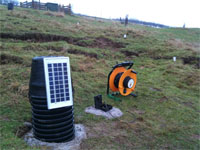
Thought to be the first system of its kind in the world, it works by measuring and analyzing the acoustic behavior of soil to establish when a landslide is imminent so preventative action can be taken.
These 10 electric delivery trucks will ultimately be part of the largest planned fleet of commercial all-electric trucks in North America.
Coffee shops and fast-food eateries could reduce their energy use more than 50 percent with ultra-efficient appliances, lights and heating, ventilation and air-conditioning systems, and other integrated design methods, according to a new report by the Department of Energy's Pacific Northwest National Laboratory.

Hydroelectric power is the oldest and the "greenest" source of renewable energy. In Germany, the potential would appear to be completely exploited, while large-scale projects in developing countries are eliciting strong criticism due to their major impact on the environment.
The device uses a sensitive carbon dioxide-sensing mechanism that can locate the signature of a single bed bug behind a wall or in a concealed space, according to Stern Environmental Group.
The Energy Regenerator may be used in power plant cooling systems and potable water treatment and distribution systems.
Formaldehyde is a known eye, nose, and throat irritant, and in 1991, EPA classified formaldehyde as a probable human carcinogen. Formaldehyde-based resins are sometimes used as adhesives in composite wood products.
To date, 1,627 sites have been listed on the NPL. There have been 346 sites deleted from the NPL with 1,281 sites remaining. With the proposal of nine new sites and one site being withdrawn from proposal, there are 62 proposed sites awaiting final agency action: 57 in the general Superfund section and five in the federal facilities section.

More than 5,300 home and workplace charging stations will be installed in Michigan.

With a genesis in recycling, it’s no surprise that Cascades Tissue Group is doing all it can to minimize its impact on the environment and perhaps help others in the process.
Honde LLC, a partner of the University of Utah, is using heightened ozonation treatment to remediate a site on the shore of Lake Taihu.
The 25-year plan advances potential future contingency resources, such as stormwater capture and seawater desalination.
Automaker showcases CNG vehicle for the first time at the Green Fleet Conference.
The board is looking to repair a crack in the interior, erosion control lining of the C.W. Bill Young Regional Reservoir.
The Institution Recycling Network has teamed with the Deconstruction & Reuse Network to expand its capabilities to facilitate reuse of surplus property in California.

New data on 23 Democratic House incumbents show that support for climate change bill could help in tough races.
Alion will conduct research on human pollutant exposures while Tetra Tech will support the federal agency's landfill methane outreach program.
The effort is expected to create a LEED-style program for water conservation.
New York-based Riverkeeper filed a petition to force the creation of federal standards for the disposal of cement kiln dust, which can be harmful to water quality.
Comments on the proposal are due by Dec. 14. The rule will require reduced use of fossil fuel-generated energy in new federal buildings and federal buildings undergoing major renovation.